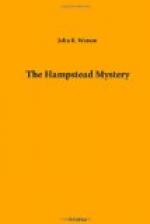“Exactly what I thought,” said Inspector Chippenfield, looking hard at Crewe so that the latter should not question his good faith.
“Then there are sometimes slight differences in the alternate letters written by the same hand. Look at the ‘T’ in ‘last’ and the ‘T’ in ’night’—the marked variation in the length and angle of the cross stroke. It is evident that the writers were labouring under serious excitement when they wrote this.”
Rolfe was so interested in Crewe’s revelations that he stood beside the deductive expert and studied the paper afresh.
“And now, about finger-prints?” asked Crews.
“None,” was the reply of the inspector, “We had it under the microscope at Scotland Yard.”
“None?” exclaimed Crewe, in surprise. “Why adopt such precautions as wearing gloves to write a note giving away this startling secret?”
“Easy enough,” replied Inspector Chippenfield. “The people who wrote the note either had little or nothing to do with the murder, but were afraid suspicion might be directed to them, or else they are the murderers and want to direct suspicion from themselves.”
“And now for the bullets,” said Crewe, “I understand two shots were fired.”
“From two revolvers,” said the inspector. “Here are both bullets. This one I picked out of the wall over there. You can see where I’ve broken away the plaster. This one—much the bigger one of the two—was the one that killed Sir Horace. The doctor handed it to me after the post-mortem.”
“Did Sir Horace keep a revolver?”
“The butler says yes. But if he did it’s gone.”
Crewe stood up and examined the hole in the wall where Inspector Chippenfield had dug out the smaller bullet.
“Sir Horace made a bid for his life but missed. Of course, he had no time to take aim while there was a man on the other side of the room covering him, but in any case those fancy firearms cannot be depended upon to shoot straight.”
“You think Sir Horace fired at his murderer—fired first?” asked Rolfe.
“This small bullet suggests one of those fancy silver-mounted weapons that are made to sell to wealthy people. Sir Horace was a bit of a sportsman, and knew something about game-shooting, but, I take it, he had no use for a revolver. I assume he kept one of those fancy weapons on hand thinking he would never have to use it, but that it would do to frighten a burglar if the occasion did arise.”
“And when he was held up in this room by a man with a revolver he made a dash for his own revolver and got in the first shot?” suggested Rolfe, with the idea of outlining Crewe’s theory of how the crime was committed.
“It is scarcely possible to reconstruct the crime to that extent,” said Crewe with a smile. “But undoubtedly Sir Horace got in the first shot. If he fired after he was hit his bullet would have gone wild—would probably have struck the ceiling—whereas it landed there. Let us measure the height from the floor.” He pulled a small spool out of a waistcoat pocket and drew out a tape measure. “A little high for the heart of an average man, and probably a foot wide of the mark.”




